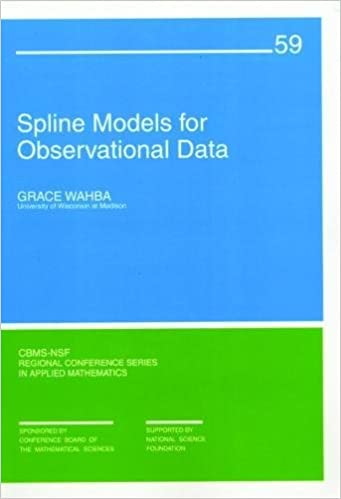

 |

|

The average rating for Spline models for observational data based on 4 reviews is 3.5 stars.
Review # 1 was written on 2008-11-24 00:00:00 Kyle Horner Kyle HornerWahba is brilliant, and this book is full of fantastic information. Unfortunately, as a brilliant mathematician, she is also incapable of communicating with mortals. This book is "concise", which in mathematician-ese means "cannot be comprehended by any except people who are already experts in the field". So, basically, if you already know what's in this book, then you can read it. Otherwise, it's an exercise in excruciation. Rewarding, if you can get through it, but agony in every step. (And just to be clear, it's not like I'm a mathematical novice here -- I've been studying statistics at one level or another for more than a dozen years here. I have a PhD in machine learning, which means, essentially, computational statistics. I'm cool with Bayesian statistics, functional analysis, topology, etc. I read abstract algebra and analysis for fun. And this book is still like chewing on broken glass for me.) This book covers a lot of good information about smoothing splines and reproducing kernel Hilbert spaces (RKHSs), including polynomial splines, thin plate splines, and Kriging estimators. It's all terribly useful stuff, and she does build them up from the ground. Unfortunately, she commits essentially all of the classic sins of a lazy mathematician. She skips almost every step, she offers no explanations for most of the steps that she does bother to include, she doesn't motivate most of her development, she changes notation without warning, she fails to define terms, she gives nothing even vaguely resembling an overview or "big picture", she doesn't clearly state results and theorems, she implies that axioms are consequences and vice versa, she gives no examples or intuition, etc. etc. It's essentially a textbook on how not to write mathematics. I would have given this book 1 star and filed it under "to be forcefully thrown", but it does have enough good information that I can't quite bring myself to do so. Still, if you can get this information from any other source, I would highly recommend that you do so. I hear that Gu has a good text in this area. That's on my to-read list... |
Review # 2 was written on 2013-05-07 00:00:00 Amber Bippert Amber BippertGreat book! This can be used as a study guide or even as a textbook, I guess. There are many worked examples and questions to solve. Everything has been explained concisely. Using this book to study probability and statistics is much better than going through those thick, long and boring textbooks. |
Review # 3 was written on 2008-11-24 00:00:00 Carol Riseing Carol RiseingWahba is brilliant, and this book is full of fantastic information. Unfortunately, as a brilliant mathematician, she is also incapable of communicating with mortals. This book is "concise", which in mathematician-ese means "cannot be comprehended by any except people who are already experts in the field". So, basically, if you already know what's in this book, then you can read it. Otherwise, it's an exercise in excruciation. Rewarding, if you can get through it, but agony in every step. (And just to be clear, it's not like I'm a mathematical novice here -- I've been studying statistics at one level or another for more than a dozen years here. I have a PhD in machine learning, which means, essentially, computational statistics. I'm cool with Bayesian statistics, functional analysis, topology, etc. I read abstract algebra and analysis for fun. And this book is still like chewing on broken glass for me.) This book covers a lot of good information about smoothing splines and reproducing kernel Hilbert spaces (RKHSs), including polynomial splines, thin plate splines, and Kriging estimators. It's all terribly useful stuff, and she does build them up from the ground. Unfortunately, she commits essentially all of the classic sins of a lazy mathematician. She skips almost every step, she offers no explanations for most of the steps that she does bother to include, she doesn't motivate most of her development, she changes notation without warning, she fails to define terms, she gives nothing even vaguely resembling an overview or "big picture", she doesn't clearly state results and theorems, she implies that axioms are consequences and vice versa, she gives no examples or intuition, etc. etc. It's essentially a textbook on how not to write mathematics. I would have given this book 1 star and filed it under "to be forcefully thrown", but it does have enough good information that I can't quite bring myself to do so. Still, if you can get this information from any other source, I would highly recommend that you do so. I hear that Gu has a good text in this area. That's on my to-read list... |
Review # 4 was written on 2013-05-07 00:00:00 C Jacobs C JacobsGreat book! This can be used as a study guide or even as a textbook, I guess. There are many worked examples and questions to solve. Everything has been explained concisely. Using this book to study probability and statistics is much better than going through those thick, long and boring textbooks. |
CAN'T FIND WHAT YOU'RE LOOKING FOR? CLICK HERE!!!